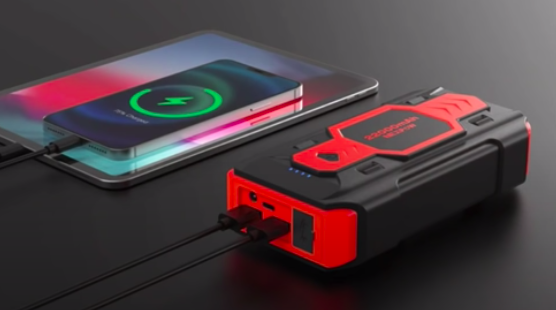How Can We Help?
Portable jump starters versus jumper cables

I was camped in Quartzsite when a fellow approached. “Do you have a jump pack I could use?” He explained he had accidentally run down the battery on his super duty diesel pickup and had used up his two portable jump starters as well as a friend’s.
“I don’t have a jump starter, but I have cables,” I replied.
He looked at me like I had come from the ancient past, or from another planet. “Oh, okay.”
I pulled around to his campsite and in a minute or two we had his truck roaring like the mighty beast it was. Low tech saved the day.
Portable jump starters are great when you’re all alone, out in the boonies, far from help. And you can use them to power up your electronics. But, of course, you need to keep the pack charged, either via the grid or your vehicle electrical system. If your vehicle starter battery is weak because the alternator is on its last legs, then it’ll be a challenge charging your battery and jump pack at the same time.
As the story above demonstrates, sometimes a portable jump starter won’t be enough to get the job done with stubborn vehicles. I once helped a guy in a tourist trap parking lot. His Camry seemed to have a fuel delivery problem of some kind. Dirty filter, clogged injectors, failing pump… whatever. I hooked up the jumper cables and he cranked and cranked and cranked until the car finally burped, shuddered and chugged to life. Like the guy with the diesel pickup, he would’ve drained a jump pack or two.
If your rig has chronic starting problems, it’s probably better to put the money you might spend on a jump pack toward fixing that problem.

I considered getting a portable jump starter, but then I realized I already had spare batteries—the ones connected to my solar power system. I knew my starter battery was getting old, and one day it gave up the ghost. So I connected the jumper cables to the house batteries. Vroom, back in business, and off to buy a new starter battery.
Portable jump starters are perfect for some people in some situations. But it’s a good idea to have jumper cables too.
WHAT TO LOOK FOR IN A PORTABLE JUMP STARTER
- Enough power to start your engine size and type
- Good recharge times
- Reverse polarity protection
- Overcharge protection
- Undercharge protection
- Back flow protection
- Spark proof technology
- The type of USB port(s) you need
THE CORRECT WAY TO USE JUMPER CABLES
- Both vehicles off and in park
- Connect the red clamp to the + terminal of the dead battery
- Connect the red clamp to the + terminal of the good battery
- Connect the black clamp to the – terminal of the good battery
- Connect the black terminal to a steel or iron engine part on the vehicle with the dead battery (Connecting the black clamp directly to the dead battery will cause sparking)
- Start the good vehicle and let it run for a few minutes
- Start the dead vehicle and immediately disconnect the jumper cables—in reverse order
Al Christensen has been living happily in a self-converted van since 2013. With jumper cables.
